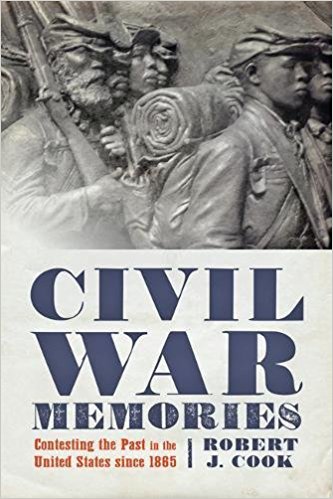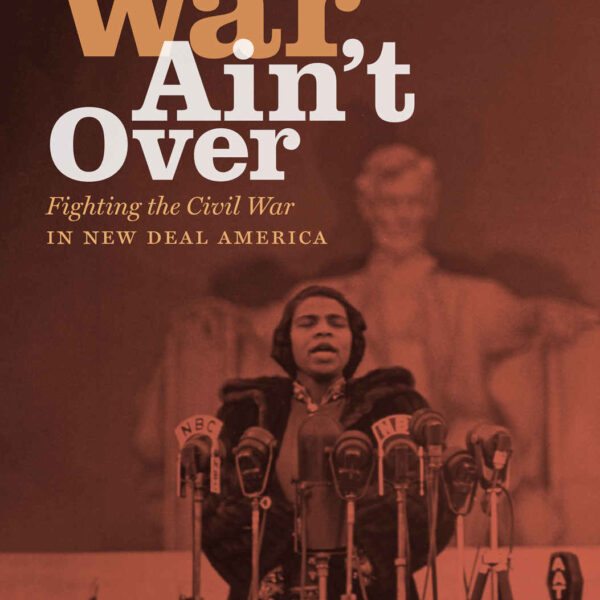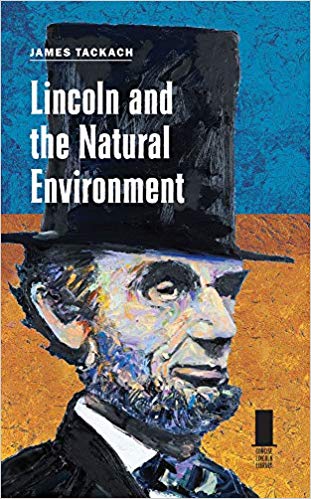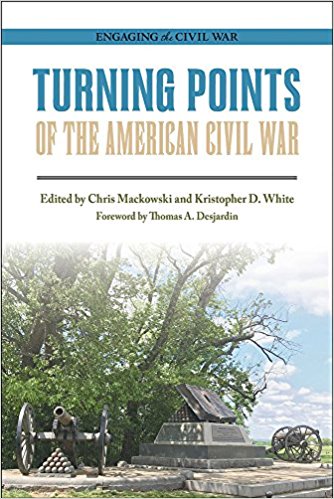Civil War Memories: Contesting the Past in the United States since 1865 by Robert J. Cook. Johns Hopkins University Press, 2017. Paper, ISBN: 978-1421423494. $24.95.
 On June 17, 2015, white nationalist Dylann Roof walked into Emanuel African Methodist Episcopal (A.M.E.) Church in downtown Charleston. Midway through an evening Bible study session, Roof produced a semi-automatic handgun, opened fire, and killed nine members of the congregation, including its pastor. The racial motivations for the terror attack—verified by photographs of Roof draped in Confederate regalia and an online manifesto promoting race war—reignited a debate in South Carolina concerning the place of Confederate symbols on government property. Less than a month after the attack, Governor Nikki Haley signed a bill removing a flag bearing the Cross of St. Andrew (better-known as the “Rebel Flag” or the “Confederate Battle Flag”) from the State Capitol and tweeted that it was “a new day in South Carolina.”
On June 17, 2015, white nationalist Dylann Roof walked into Emanuel African Methodist Episcopal (A.M.E.) Church in downtown Charleston. Midway through an evening Bible study session, Roof produced a semi-automatic handgun, opened fire, and killed nine members of the congregation, including its pastor. The racial motivations for the terror attack—verified by photographs of Roof draped in Confederate regalia and an online manifesto promoting race war—reignited a debate in South Carolina concerning the place of Confederate symbols on government property. Less than a month after the attack, Governor Nikki Haley signed a bill removing a flag bearing the Cross of St. Andrew (better-known as the “Rebel Flag” or the “Confederate Battle Flag”) from the State Capitol and tweeted that it was “a new day in South Carolina.”
The massacre at Mother Emanuel simultaneously underscores the endurance of Civil War memory in the contemporary United States and the extent to which Americans still struggle, often violently, to control the fundamental meanings of those memories. Very appropriately, then, Charleston and its aftermath comprise the opening vignette of Robert Cook’s Civil War Memories. The scope of the book is gargantuan; it attempts to backtrack from Dylann Roof to Appomattox, providing comprehensive coverage of how and why Americans have remembered the Civil War via a litany of mediums: in literature, on film and television, through monuments, art, and reenactments, at national park sites, in politics, and from the pulpit.
The results are mixed. Cook makes good on his chronological ambition—managing to condense 150 years of remembering and commemoration into a volume of roughly 200 pages. At the same time, though, it is generally unclear who this book is actually for; that is, at first glance Cook appears to have created a marvelous new tool, but upon closer inspection, one with limited opportunities for application.
After providing a brief synopsis of the conflict itself, the first part of the book (four chapters) treats from 1865 to approximately the turn of the twentieth century. Cook covers the familiar schools of Civil War legacy-making (Emancipationist, Unionist, White Supremacist, Reconciliationist) and recaps the creation of veterans’ organizations such as the Grand Army of the Republic (GAR) and the United Confederate Veterans (UCV)—as well as their progeny, the United Daughters of the Confederacy (UDC) and the Sons of Confederate Veterans (SCV). These early chapters also touch on familiar topics like Century’s “Battles and Leaders” series, the construction of well-known Union and Confederate monuments, Blue/Gray Reunions, the preservation of battlefield parks, and the collision of a rapidly aging (and disappearing) Civil War generation with a new wave of commemoration-hungry veterans just home from Cuba and the Philippines. In many ways, this section of the book constitutes a throwback to institutional histories of Civil War memory, particularly to works chronicling the intellectual architects and organizational structure of the Lost Cause Movement.
The second part of the book engages topics ranging from the First World War and the Progressive Movement to the Obama presidency, or what Cook considers the “Modern Era” of postbellum U.S. history. In these chapters Cook outlines developments in film and television, ranging from The Birth of a Nation (1915) to Ken Burns’ Civil War (1990) to 12 Years a Slave (2013); the evolving legacy of Abraham Lincoln; and literary trends spanning from Douglas Southall Freeman and the Vanderbilt Agrarians to Bruce Catton and Shelby Foote. On broader terms, Cook also pieces together how Civil War memory changed in relation to major upheavals or periods of social turbulence like the Great Depression, World War II, the Cold War, and the Civil Rights Movement. The book ends with attention paid to the Civil War Sesquicentennial and the very beginnings of the debate over Confederate monument removal. In fairness to Cook, the latter movement hit its apex after this book would have begun final production—making in-depth reporting on the tragedy at Charlottesville or events in Memphis and New Orleans impossible to include.
Overall, Cook has produced a concise, clearly-written, and largely synthetic volume that surveys major trends and developments in Civil War memory from 1865 to 2015. Owing to those qualities, Civil War Memories functions much like a pocket textbook on the subject. But this raises the all-important question of readership. Namely: who is the target audience of a reference-style work of this kind?
On one hand, while Cook is an undeniably strong writer, the style necessary to compact 150 years into 200 pages simply does not lend itself to the sort of storytelling required to capture a large popular audience—nor to making inroads as an assigned text in undergraduate classrooms. On the other hand, the synthetic nature of the book likely means that most professional historians will return to the original monographs upon which it is based for deeper analysis of a given topic. This leaves very specialized upper-division courses and possibly graduate colloquia as its main targets. The exceptions here are the last chapter, entitled “Afterlife,” and an epilogue, “The Continuing Civil War.” Both provide sharp and original commentary on the Civil War Sesquicentennial and relevant commemorative debates still ongoing—and unlikely to cease anytime soon—in Trump’s America. Regardless of how they come to it, readers in search of a crash course on the subject will find exactly what they desire in Civil War Memories.




